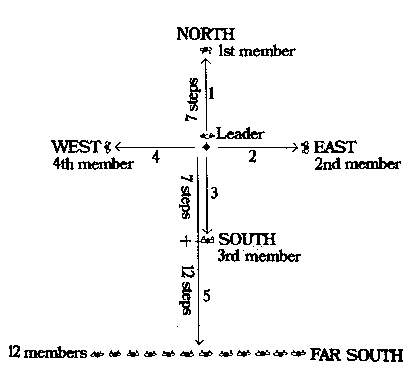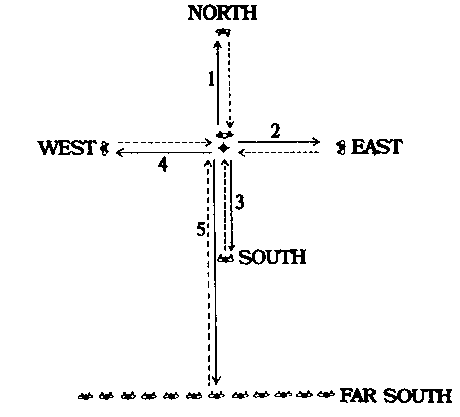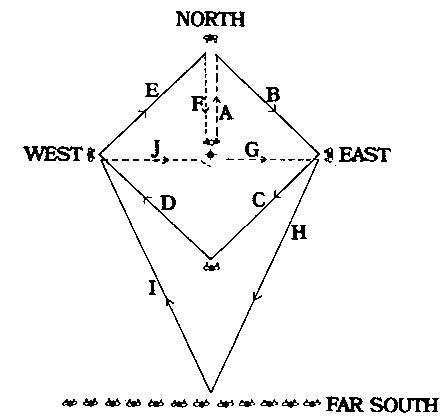
Although Father himself did not establish a Holy Ground until 1965, on January 1, 1963, he wrote the words "Holy Ground" in Chinese characters, and shared with those present his determination and plan to reclaim God's lands symbolically first through Holy Grounds, and later by restoring the homeland.
Originally all land belonged to Heavenly Father; it was His creation. Because of the fall, however, God lost everything. After Father's Holy Marriage in 1960, it became possible to regain land for God through establishing Holy Grounds. It was possible for Father to establish or direct the establishment of Holy Grounds because, as God's repre- sentative, he could reinstate God's ownership of certain territories. Neither Adam nor Jesus was able to accomplish this, because the second blessing of God must precede the third blessing; therefore, Jesus could establish only a spiritual kingdom.
Furthermore, as Holy Grounds are heavenly property, Father, at minimum, returns them from Satan's dictatorship to God's rightful ownership. Symbolically, Holy Grounds are God's territory. In our prayers, we should visualize that Holy Ground will extend over the whole nation and ultimately the whole world.
Holy Ground is a representative area of a nation or city; it is God's place, a place where He is more free to hear our prayers Through His representative, God symbolically restores that land as His own property.
The first Holy Grounds were founded in Korea by several of Father's disciples, according to Father's instruction, before he himself actually established any. The locations and the dates the Holy Grounds were founded follow.
October 5, 1962: Holy Grounds founded by Hyo Won Eu, Young Whi Kim, and Chung Hwan Kwak
October 6, 1962: A Holy Ground founded by In Soo Han, Young Whi Kim, and Chung Hwan Kwak
Young Whi Kim and Chung Hwan Kwak founded the following Holy Ground
October 7, 1962: Holy Ground founded by Young Whi Kim and Chung Hwan Kwak
From January 28, 1965 through October 10, 1965, Father made Holy Grounds in 39 nations. He returned to Korea and created Holy Grounds in each regional district before establishing the last seven (main) Holy Grounds in Seoul, including the one in Chungpadong Church.
The five Holy Grounds listed above founded by the disciples were later established as official Holy Grounds by Father as part of these seven Holy Grounds. He finished blessing 120 Holy Grounds throughout the world on January 1, 1966. A list of Holy Grounds established by Father himself is included at the end of this chapter.
After Father designated the main regional Holy Grounds in Korea, each regional director was then able to establish other local Holy Grounds.
The state leader or national director is completely responsible to see that the Holy Ground itself, as well as the area surrounding it, is well kept. He or she should assign someone to clean, plant and attend to each Holy Ground, especially those which True Father himself established.
In Korea, Pledge service was often held at Holy Ground, even in the winter. Many Korean members still go to Holy Grounds to hold Pledge service, daily morning prayers, or all-night prayer vigils. This is a pattern which other nations or centers may wish to follow.
True Father has often emphasized that members should pray at Holy Grounds as often as possible.
The atmosphere at Holy Ground is sacred. When we pray at a Holy Ground, our prayers relate to the historical foundation of comforting God's heart through reclaiming His land. Because of this, prayers offered at Holy Ground have a greater effect.
Given the significance of Holy Ground, we should feel it is different from other places. Our mind and attitude should be more pious; we should feel closer to God.
At least one Holy Ground should be made in each city of a country in which there is a center.
The person making the Holy Ground should select a central place. A particularly distinct rock or tree, or an important landmark would be appropriate. When selecting the area, the person should keep in mind that it will be the members' place of prayer. Therefore, he or she should try to select a place at the top of a hill or an area with a beautiful view, for example.
All Holy Grounds should be made outdoors. The only indoor Holy Ground is the main hall of the Chungpadong Church.
If at all possible, purchase land chosen as Holy Ground. In principle, land bought for this purpose should never be sold.
It is very important that pictures be taken of each Holy Ground and that clear maps of its exact location (e.g., landmarks and surrounding area) be made. These records should be kept by each state or pro- vincial and national headquarters. A copy of the description of the state or provincial Holy Ground (including pictures and map) should be sent to the national headquarters.
Each national headquarters should send copies of the records and maps of major Holy Ground(s) (especially those made by True Father) to international headquarters.
The essential materials for making a Holy Ground are Holy Salt and some soil (earth), including small rocks or pebbles from an established Holy Ground, preferably one made by True Father himself.
The leader should select a minimum of five members (ideally 17 or more) to help him or her establish the new Holy Ground.
The leader should go to the central place (tree, rock, etc.) chosen as Holy Ground and bury the pebbles and soil brought from an original Holy Ground along with a small portion of Holy Salt.
From the central point, the leader should then face north and walk seven steps (refer to diagram 9.1-1). One of the members should stand at this place and face the central point. The leader should walk back to the central point, face the east and walk seven steps (9.1-2). One member should walk to that place and stand. The leader should then walk back to the central point and follow this same format going south (9.1-3), then west (9.1-4). One member should stand at the south, and one at the west position also. They should also face the central point.
After the leader returns to the central point from the west, he or she should face south and then walk to the far south position (an additional twelve steps from the south position (9.1-5). Twelve members (if that

many additional members were able to attend) should stand at the far south position (as indicated in diagram 9.1). If more members are present, they should stand three steps in back of the twelve members, but no more than twelve should stand at the far south position.
The leader should return to the central point once again and face south. All other members should be facing toward the central point.
The leader should pray so as to include the following points:
According to diagram 9.2, the leader should take Holy Salt and walk the seven steps to the north (9.2-1), sprinkling it as he goes. He should then return to the central point, and sprinkle Holy Salt as he walks seven steps to the east (9.2-2), and return once again to the central point. This same format should be followed going to the south (9.23), west 9.2-4) and far south (9.2-5) and return to the central point.
After this, he or she should walk again to the north (9.3-A) (not using Holy Salt) and then sprinkle Holy Salt walking from north to east (9.3-B) then east to south (9.3-C), south to west (9.3-D), and west to north (9.3-E). The leader should then return to the central point (9.3-F) (not using Holy Salt) and walk from the central point to the east position (also not using Holy Salt) (9.3-G). He or she should then sprinkle Holy Salt, walking from east to far south (9.3-H), far south to west (9.3-I), and from the west, walk to the central point (9.3-J).
The leader should face south and pray a prayer of gratitude and determination.
A step-by-step outline of the format follows:


If at least five members cannot participate in the establishment of a Holy Ground, the leader may walk seven steps to each of these locations (north, east, south, west, and beyond the far south position) and place a symbolic item (rock, etc.).
It is physically impossible to actually sprinkle Holy Salt along the route from the original Holy Ground (from which the soil and pebbles are taken) to the area in which a new Holy Ground will be made. It is therefore important to sprinkle or spread a bit of Holy Salt at the site of the original Holy Ground when removing the soil and pebbles which will be buried at the new one. Bring this Holy Salt and the soil and pebbles when traveling to the location for the new Holy Ground. Doing so will symbolically "sprinkle" Holy Salt from the original Holy Ground to the new one to be made.
At the outset of establishing a new Holy Ground, the leader should also pray that a connection between the two Holy Grounds be made.
If it is known that a Holy Ground was established incorrectly, the responsible person should first report this to the regional, national, or international headquarters.
With the permission of the national or international headquarters, a designated leader should visit the Holy Ground and either pray according to the contents of the prayer used to make one, or simply use the steps outlined above to re-sanctify the Holy Ground.
On occasion, a temporary Holy Ground is established. In one sense, though, any Holy Grounds established by city leaders and even mis- sionaries may be considered "temporary." When a church elder visits the Holy Ground, he is able to designate it as a permanent one.
A temporary Holy Ground could be established during a 40 day pioneer witnessing condition or when a member is sent to pioneer a city. When establishing a temporary Holy Ground, indicate it as such in prayer.
In principle, do not establish a (temporary) Holy Ground and leave the city without "closing" it. Visit this Holy Ground and offer a prayer informing Heavenly Father that this land is now terminated as a Holy Ground.
No Holy Ground established by Father himself should be "closed," even if centers in those cities are temporarily or permanently closed due to a national reorganization, consolidation, or any other reason.
If the land on which Holy Ground (e.g., a park) is located is bought or rented (i.e., by the government or a corporation) and used for another purpose, making it impossible for it to be used as a Holy Ground any longer, choose another area (as a temporary replacement) and transfer the location of the Holy Ground. When a church elder is able to visit, he or she will be able to designate it as a new Holy Ground.
Japan
1. Tokyo (Meige Shlisne) 1.31.65
2. Nagoya 2.02.65
3. Osaka 2.03.65
4. Damagas 2.04.65
5. Hiroshima 2.05.65
6. Fukuoka 2.06.65
7. Hokkaido 2.09.65
8. Sendai 2.10.65
United States
9. San Francisco, California 2.15.65
10. Los Angeles, California 2.21.65
11. Mt. Whitney, California 2.25.65
12. Death Valley, California 2.25.65
13. Las Vegas, Nevada 2.26.65
14. Phoenix, Arizona 2.27.65
15. Albuquerque, New Mexico 2.28.65
16. Dallas, Texas 3.01.65
17. Oklahoma City, Oklahoma 3.02.65
18. Kansas City, Kansas 3.03.65
19. St. Louis, Missouri 3.04.65
20. Paducah, Kentucky 3.05.65
21. Memphis, Tennessee 3.05.65
22. Little Rock, Arkansas 3.06.65
23. Jackson, Mississippi 3.06.65
24. New Orleans, Louisiana 3.06.65
25. Mobile, Alabama 3.07.65
26. Tampa, Florida 3.08.65
27. Miami, Florida 3.08.65
28. Savannah, Georgia 3.10.65
29. Columbia, South Carolina 3.11.65
30. Raleigh, North Carolina 3.11.65
31. Richmond, Virginia 3.11.65
32. Martinsburg, Virginia 3.12.65
33. Washington, D.C. 3.14.65
(Ellipse Park behind White House)
34. Washington, D.C. 3.14.65
(National Shrine, Capitol Building.)
35. Baltimore, Maryland 3.18.65
36. Wilmington, Delaware 3.18.65
37. Philadelphia, Pennsylvania 3.18.65
38. Trenton, New Jersey 3.18.65
39. New York, New York 3.19.65
40. New Haven, Connecticut 3.19.65
41. Providence, Rhode Island 3.19.65
42. Boston, Massachusetts 3.19.65
43. Portsmouth, New Hampshire 3.19.65
44. Kittery, Maine 3.19.65
45. Brattleboro, Vermont 3.20.65
46. Cleveland, Ohio 3.21.65
47. Detroit, Michigan 3.21.65
48. Hammond, Indiana 3.21.65
49. Chicago, Illinois 3.22.65
50. Madison, Wisconsin 3.22.65
51. St. Paul, Minnesota 3.23.65
52. Fargo, North Dakota 3.23.65
53. Sioux Falls, South Dakota 3.23.65
54. Sioux City, Iowa 3.23.65
55. Lincoln, Nebraska 3.24.65
56. Cheyenne, Wyoming 3.24.65
57. Denver, Colorado 3.25.65
58. Salt Lake City, Utah 3.26.65
59. Boise, Idaho 3.26.65
60. Missoula, Montana 3.27.65
61. Seattle, Washington 3.28.65
62. Portland, Oregon 3.29.65
63. Eugene, Oregon 3.29.65
Other Nations
64. Ottawa, Canada 7.02.65
65. Panama City, Panama 7.04.65
66. Bogota, Colombia 7.05.65
67. Santiago, Chile 7.06.65
68. Buenos Aires, Argentina 7.06.65
69. Rio de Janeiro, Brazil 7.09.65
70. Lisbon, Portugal 7.11.65
71. Madrid, Spain 7.13.65
72. London, England 7.15.65
73. Copenhagen, Denmark 7.20.65
74. Oslo, Norway 7.24.65
75. Stockholm, Sweden 7.24.65
76. Berlin, Germany 7.26.65
77. Frankfurt, Germany 7.29.65
78. Essen, Germany 8.05.65
79. Amsterdam, The Netherlands 8.08.65
80. Brussels, Belgium 8.09.65
81. Luxembourg, Luxembourg 8.09.65
82. Paris, France 8.10.65
83. Geneva, Switzerland 8.13.65
84. Alps Mountains, Switzerland 8.13.65
85. Baduka, Liechtenstein 8.15.65
86. Vienna, Austria 8.16.65
87. Rome, Italy 8.19.65
88. The Vatican, Italy 8.20.65
89. Athens, Greece 8.22.65
90. Cairo, Egypt 8.25.65
91. Amman, Jordan 8.29.65
92. Gergian, Jordan 8.31.65
93. Mountain near Gethsemane, Israel 8.31.65
94. Hebron, Jordan 9.01.65
95. Damascus, Syria 9.03.65
96. Beirut, Lebanon 9.05.65
97. Teheran, Iran 9.06.65
98. New Delhi, India 9.08.65
99. Singapore, Singapore 9.15.65
100. Jahor, Malaysia 9.15.65
101. Bangkok, Thailand 9.17.65
102. Saigon, Viet Nam 9.19.65
103. Manila, The Philippines 9.22.65
104. Hong Kong, Hong Kong 9.25.65
105. Taipei, Taiwan 9.28.65
Korea
106. Chun Cheon 12.08.65
107. Chung Ju 12.11.65
108. Taegu 12.12.65
109. Pusan 12.14.65
110. Kwang Ju 12.17.65
111. Jeon Ju 12.18.65
112. Dae Jeon 12.19.65
113. Soo Won 12.22.65
114. Seoul-Goo Jin Bong Mountain 12.31.65
115. Seoul-In Wang Mountain 12.31.65
116. Seoul-Heuk Suk Dong 12.31.65
117. Seoul-Tae Neung 12.31.65
118. Seoul-Nam Mountain 1.01.66
119. Seoul-Dobong Mountain 1.01.66
120. Seoul-Chungpadong Church 1.01.66